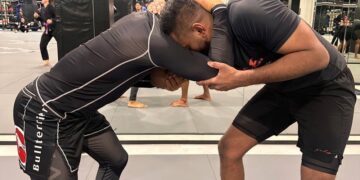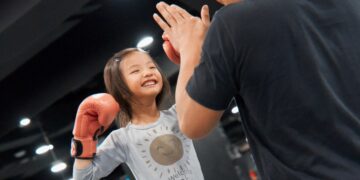
Posture is an essential aspect of BJJ and life. From a grappling perspective, it is a defense mechanism to prevent getting caught by threats on the mats and is an effective way to impose your will against the opponent. On the other hand, good posture is an ingredient for overall longevity and good health. In this article, we will talk about how you can utilize posture in BJJ.
What Is Posture In BJJ?
Generally, posture refers to the position and alignment of the spine with the head, shoulders, and hips when standing or sitting. In BJJ, having good posture means maintaining a good alignment of the spine, making it easier to generate force in different scenarios. Having good posture when placed in various positions in BJJ is critical as it enables you to pull off the techniques you want to impose against the opponent.
On the other hand, to have or be in bad posture in BJJ means that your spine is misaligned in your current position, which can put you at a disadvantage and be utilized by the opponent as an opening for an attack. Some beginners can build such habits, which can be detrimental to their game, like facing down in stand-up or when passing the guard, making it easier for the opponent to snap their head down and break their posture.
Remember, to have better posture; other than working out outside the mats, grapplers must develop situational awareness, keeping in mind the head position and body alignment during the execution of the techniques. As the famous saying in BJJ goes, where the head goes, the body follows.
Utilizing Posture In BJJ
Utilizing good posture in BJJ is critical. Some scenarios require maintaining good posture, while sometimes it can be relaxed to conserve energy depending on the situation; it can be the difference between being put in an inferior position or helping you keep a dominant one. Consider the situations below when studying applying good posture in BJJ.
Passing The Guard
Assuming you’re passing the opponent’s spider guard with them having control over your upper body through both your sleeves, the more you lean forward, the better control the opponent will have. You can change your posture by sitting back and pulling the opponent down by grabbing their pants. Doing so makes it difficult for the opponent to move their hips, making it easier for you to clear their legs.
Relatively, when the opponent starts playing the De La Riva guard while pulling your collar down to control your upper body, like in the closed guard, you must be wary of the triangle. To posture from the DLR, have one leg forward and one leg back with your elbow connected to your knee as if you’re doing a combat base.
On the defense, you want a leaning-back posture or pressure forward using both legs to drive if you’re going to attack. While keeping good upper body posture as you drive forward with your legs and elbows tucked into your body, you can break down the opponent’s DLR hook.
Escaping From Submissions
A typical way to use the posture-up method is when defending from the triangle in closed guard. Before going into the submission escape, remember that when inside the opponent’s closed guard, you first want to avoid being put in the triangle. The most common way to do this is to keep both your arms on the outside of the opponent’s legs or inside their guard planted on their thigh.
Remember not to reach in with one arm, as the opponent can shoot up the triangle. If the opponent catches you with the triangle, protect your trapped arm by shooting your elbow to their hip and locking both your hands. Sit back as you look up to force your body into an upright posture. While keeping a strong posture, come up to your knees, bring your two hands on top of the opponent’s knee, and push it down straight to the mat to force the triangle to open.
Engaging In Stand-Up
A key concept about posture when engaging in stand-up is if the opponent’s head is more in line with their hips, that’s when you apply a pushing motion to force the opponent backward. If the opponent’s head starts coming down more than 45 degrees relative to their hips, it is better to force them forward by pulling or dragging, but it’s more difficult for you to push them backward as their head is aligned to their hips at a 45-degree angle.
Relatively, if the opponent is standing upright, it will be difficult for you to drag their head down but easier for you to push them back. To set up attacks allowing you to control the opponent’s head and posture, you must create situations to get their head forward in front of their hips. You can make a distraction by attempting to attack their lower body if the opponent’s posture is upright.
In this way, the opponent’s leg will begin to step back as their head starts coming forward. This allows you to break the opponent’s stance and set up head drags that enable you to apply the front headlock and control their posture.
Finishing Takedowns
As mentioned above, good posture is critical when finishing takedowns. Not only will it safeguard your takedown attempt, but it also prevents you from getting countered. Using the single leg as an example, you want your body in a strong position when getting to your single-leg shots. Remember that in an inside or outside head single leg, always keep your body in a strong position, which means having your knees slightly bent, your back straight at a 45-degree angle, and your head up.
If any of these deteriorate, like your knees straightening out, back starting to bend, and head starting to go down, you risk getting caught in a submission, thrown over, or the opponent escaping, putting the energy you exert into the attempt. As a piece of advice, where your eyes go, your head tends to follow, and where your head is, the body follows. Use this principle when finishing takedowns like the single leg, when your head is posted on the opponent’s chest to push them off balance.
Conclusion
Good posture is essential in producing power and maintaining stability and balance. It aids in effectively executing techniques and reduce risks. Keep in mind the different ways you can utilize posture in BJJ and see how it affects the progress of your game.
You may also like:
The Beginner’s Guide To The Suplex
The BJJ Leg Locks Escape Guide
In an MMA and wrestling match, the suplex is one of those techniques that will surely capture an audience’s attention. Some may think it is not for everybody and requires one to be an athletic…
Good posture comes with its share of perks like helping you make a better first impression when you meet new people. Good posture gives you an air of authority and makes you appear taller than…
In Brazilian Jiu-Jitsu and Submission Grappling, the rise of the leg lock game over the past years has been nothing short of fascinating. John Danaher famously said that leglocks and takedowns were the few weaknesses…
Brazilian Jiu-Jitsu (BJJ) is widely viewed as one of the best martial art to learn for self-defense for various reasons, like allowing smaller fighters to use leverage to defeat larger opponents. BJJ is a derivative…
In Brazilian Jiu-Jitsu and other grappling arts, mastering efficient takedowns is essential, especially as practitioners age. As flexibility, strength, and speed evolve, so must the techniques to ensure they remain effective yet safe. For older…
Brazilian Jiu-Jitsu is widely considered to be the most effective grappling-based martial art for self-defense because of how its techniques allow smaller fighters to dominate much larger and stronger opponents. One of the things that…
The uppercut is arguably the most devastating punch used in boxing. Its upward trajectory often allows it to thread between an opponent’s guard and make contact with their chin. The punch can be equally destructive…
Anatoly “Sladkiy” Malykhin is a special breed of fighter. The triple-champ from ONE Championship is the first MMA fighter to win titles in three different weight classes in a major MMA promotion, and the first…
When you first started your Muay Thai journey you were probably bursting with excitement. You went to every session possible, lapping up every bit of knowledge and advice given to you by your coaches and…
Martial art classes for kids might just be what you need to get your child off the couch and go break a sweat. Obesity rates among adolescents and children between the ages of 5 to…
The body clinch and throw is an effective technique, commonly used by many Muay Thai fighters when they are locked in a clinch battle with a taller opponent. If you are ever up against a…
Getting yourself pumped up to start a new workout routine is only half of the equation; staying motivated long enough to see the result of your hard work can be just as challenging. However, once…


































